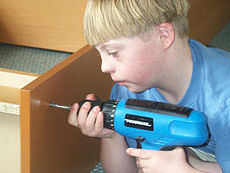Visit and Join the WeHeal Down Syndrome Community.
For more information, see: Mayo Clinic | Wikipedia

Visit and Join the WeHeal Down Syndrome Community.
For more information, see: Mayo Clinic | Wikipedia

A genetic disorder that causes lifelong mental retardation, developmental delays and other problems. Down syndrome varies in severity, so developmental problems range from moderate to serious. Down syndrome is the most common genetic cause of learning disabilities in children.Down syndrome is a condition in which a person has an extra chromosome. Chromosomes are small “packages” of genes in the body. They determine how a baby’s body forms during pregnancy and how the baby’s body functions as it grows in the womb and after birth. Typically, a baby is born with 46 chromosomes. Babies with Down syndrome have an extra copy of one of these chromosomes, chromosome 21. A medical term for having an extra copy of a chromosome is ‘trisomy.’ Down syndrome is also referred to as Trisomy 21. This extra copy changes how the baby’s body and brain develop, which can cause both mental and physical challenges for the baby.
Even though people with Down syndrome might act and look similar, each person has different abilities. People with Down syndrome usually have an IQ (a measure of intelligence) in the mildly-to-moderately low range and are slower to speak than other children.
Some common physical features of Down syndrome include:
• A flattened face, especially the bridge of the nose
• Almond-shaped eyes that slant up
• A short neck
• Small ears
• A tongue that tends to stick out of the mouth
• Tiny white spots on the iris (colored part) of the eye
• Small hands and feet
• A single line across the palm of the hand (palmar crease)
• Small pinky fingers that sometimes curve toward the thumb
• Poor muscle tone or loose joints
• Shorter in height as children and adults
Down syndrome remains the most common chromosomal condition diagnosed in the United States. Each year, about 6,000 babies born in the United States have Down syndrome. This means that Down syndrome occurs in about 1 out of every 700 babies.
Types of Down Syndrome
There are three types of Down syndrome. People often can’t tell the difference between each type without looking at the chromosomes because the physical features and behaviors are similar.
Trisomy 21: About 95% of people with Down syndrome have Trisomy 21.2 With this type of Down syndrome, each cell in the body has 3 separate copies of chromosome 21 instead of the usual 2 copies.
Translocation Down syndrome: This type accounts for a small percentage of people with Down syndrome (about 3%).2 This occurs when an extra part or a whole extra chromosome 21 is present, but it is attached or “trans-located” to a different chromosome rather than being a separate chromosome 21.
Mosaic Down syndrome: This type affects about 2% of the people with Down syndrome.2 Mosaic means mixture or combination. For children with mosaic Down syndrome, some of their cells have 3 copies of chromosome 21, but other cells have the typical two copies of chromosome 21. Children with mosaic Down syndrome may have the same features as other children with Down syndrome. However, they may have fewer features of the condition due to the presence of some (or many) cells with a typical number of chromosomes.
Visit and Join the WeHeal Down syndrome Community.
For more information, see: Mayo Clinic | Wikipedia
WeHeal is very grateful to our valued sources of information which include Wikipedia, WebMD, ClinicalTrials.gov, Cancer.gov, Infoplease, and the US CDC (Center for Disease Control).